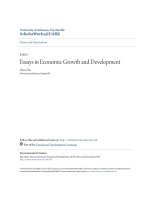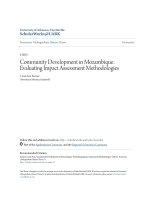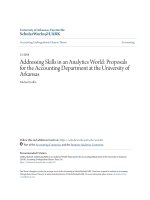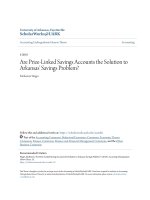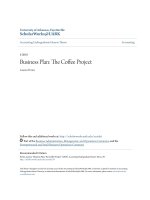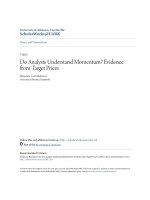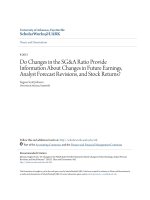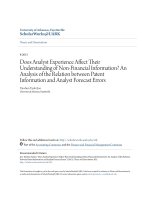Accounting undergraduate Honors theses: Do changes in the SG&A ratio provide information about changes in future earnings, analyst forecast revisions, and stock returns
Bạn đang xem bản rút gọn của tài liệu. Xem và tải ngay bản đầy đủ của tài liệu tại đây (1.75 MB, 99 trang )
University of Arkansas, Fayetteville
ScholarWorks@UARK
Theses and Dissertations
8-2013
Do Changes in the SG&A Ratio Provide
Information About Changes in Future Earnings,
Analyst Forecast Revisions, and Stock Returns?
Eugene Scott Johnson
University of Arkansas, Fayetteville
Follow this and additional works at: />Part of the Accounting Commons, and the Finance and Financial Management Commons
Recommended Citation
Johnson, Eugene Scott, "Do Changes in the SG&A Ratio Provide Information About Changes in Future Earnings, Analyst Forecast
Revisions, and Stock Returns?" (2013). Theses and Dissertations. 845.
/>
This Dissertation is brought to you for free and open access by ScholarWorks@UARK. It has been accepted for inclusion in Theses and Dissertations by
an authorized administrator of ScholarWorks@UARK. For more information, please contact ,
Do Changes in the SG&A Ratio Provide Information About Changes in Future Earnings, Analyst
Forecast Revisions, and Stock Returns?
Do Changes in the SG&A Ratio Provide Information About Changes in Future Earnings, Analyst
Forecast Revisions, and Stock Returns?
A dissertation submitted in partial fulfillment
of the requirements for the degree of
Doctor of Philosophy in Business Administration
By
Eugene S. Johnson
University of Florida
Bachelor of Science in Telecommunication, 1991
University of Florida
Bachelor of Science in Accounting, 1998
University of Florida
Master of Accountancy, 1998
August 2013
University of Arkansas
This dissertation is approved for recommendation to the Graduate Council.
Dissertation Director:
_________________________________
Dr. Linda Myers
Dissertation Committee:
_________________________________
Dr. James Myers
_________________________________
Dr. Gary Ferrier
ABSTRACT
In fundamental analysis, increases in the ratio of selling, general and administrative
(SG&A) costs to sales (SG&A ratio) are viewed as negative signals about future firm
performance. However, this interpretation focuses on the overall change in the SG&A ratio and
ignores the underlying changes in the components of the ratio. For example, prior literature finds
that the interpretation offered by fundamental analysis does not hold during periods of
decreasing sales. I contend that a further partitioning of the full sample into subsamples
representing all possible combinations of changes in the components of the SG&A ratio, and the
ratio itself, will yield incremental information about future firm performance. Accordingly, I
identify six subsamples representing these combinations of changes and examine whether they
are incrementally informative about future earnings, analyst forecasts, and stock returns. I find
that changes in the SG&A ratio in four of my six subsamples are associated with changes in
future earnings, and that results from prior literature regarding periods of decreasing sales are
driven by a specific set of circumstances. I also find that analysts do not always recognize the
information in the signals and incorporate the information into their forecast revisions. Finally, I
find that changes in the SG&A ratio in five of my six subsamples provide statistically significant
information regarding future stock returns that is not subsumed by the information contained in
forecast revisions.
ACKNOWLEDGEMENTS
I would like to thank my committee chair, Linda Myers, and my committee members,
James Myers and Gary Ferrier, for their guidance and support throughout the course of this
research. I am also grateful to the other members of the University of Arkansas accounting
faculty and my Ph.D. student colleagues who provided advice, support and encouragement at
exactly the right moments.
DEDICATION
To my wife, Ilene, your love and encouragement are the reasons I’m here, to Jacob and
Elisabeth, for being the best children a father could hope to have, and to my parents, Eugene and
Dinah Johnson, for all of their support over these past four years and throughout my life.
TABLE OF CONTENTS
1.
INTRODUCTION ...................................................................................................................1
2.
BACKGROUND .....................................................................................................................6
3.
SAMPLE, VARIABLE DEFINITIONS, AND RESEARCH DESIGN ...............................10
Sample....................................................................................................................................10
Variable Definitions ...............................................................................................................12
Empirical Models ...................................................................................................................13
4.
EMPIRICAL RESULTS ........................................................................................................17
The Relation between Changes in the SG&A Ratio and Future Earnings ............................17
The Relation between Changes in the SG&A Ratio and Analyst Forecast Revisions ..........21
The Relation between Changes in the SG&A Ratio and Stock Returns................................23
Additional Tests .....................................................................................................................25
5.
CONCLUSION ......................................................................................................................39
6.
REFERENCES ......................................................................................................................41
7.
TABLES ................................................................................................................................45
1. Introduction
In fundamental analysis, increases in the ratio of selling, general and administrative
(SG&A) costs to sales (SG&A ratio) are perceived as the inability of managers to control costs.
This inefficiency is expected to negatively impact future performance (Lev and Thiagarajan
1993; Anderson et al. 2007). Alternatively, decreases in the SG&A ratio are interpreted as a sign
of tight managerial control over costs and increased efficiency, which will lead to better future
performance. However, empirical evidence does not generally support this view. For instance,
Abarbanell and Bushee (1997) find no association between changes in the SG&A ratio and
future earnings changes.
Anderson et al. (2007) examine this lack of association and explain that the expected
impact of changes in the SG&A ratio, offered by fundamental analysis, is valid only if SG&A
costs move proportionately with increases and decreases in sales. Because Anderson et al. (2003)
find that SG&A costs decrease less when sales decrease than they increase when sales increase,
Anderson et al. (2007) partition their sample into firm-years with increasing sales and firms with
decreasing sales. They find that changes in the SG&A ratio are positively associated with future
earnings when sales are increasing and negatively associated with future earnings when sales are
decreasing. This partitioning of the sample into periods of increasing and decreasing sales
provides new findings, however prior literature does not examine the implications of changes in
both of the components of the SG&A ratio.
The SG&A ratio is affected by both sales and SG&A costs. In periods where both sales
and SG&A costs move in the same direction (i.e., both increase or both decrease), the SG&A
ratio can either increase or decrease because it is a function of the relative changes to the
separate components. For instance, in a period where sales and SG&A costs both increase, if
1
sales increase by more than SG&A costs, then the SG&A ratio will decrease, and if sales
increase by less than SG&A costs, then the SG&A ratio will increase. Because changes in the
components of the SG&A ratio may be informative about future performance, in this study, I
identify subsamples of firm-years with all possible combinations of changes in the SG&A ratio
and its components, and I examine whether these changes provide information about future
earnings, analyst forecast revisions, and stock returns.
Fundamental analysis is primarily concerned with examining specific financial statement
items and ratios in an attempt to identify information useful for predicting future earnings and
firm value. Changes in financial statement items and ratios are informative if they provide
information beyond that contained in current earnings. Prior research finds that fundamental
signals are incrementally informative about changes in future earnings, that analysts seem to
understand these signals and incorporate the information into their forecasts, and that these
signals are associated with future stock returns. However, evidence regarding the
informativeness of changes in the SG&A ratio is mixed. Anderson et al. (2007) suggest that this
may be attributable to conflicting information produced by the same signal in different
circumstances. They test this theory and find that increases in the SG&A ratio signal higher
future earnings in periods of increasing sales but signal lower future earnings in periods of
decreasing sales, indicating that changes in the SG&A ratio provide different information in
different circumstances. Given this, I investigate whether additional information about future
earnings and firm value can be obtained by identifying all combinations of increasing versus
decreasing sales, increasing versus decreasing SG&A costs, and increasing versus decreasing
SG&A ratio.
2
In general, increasing sales is a favorable signal about firm performance. However, when
sales increase, changes in the SG&A ratio are an ambiguous signal about firm performance.
When increasing sales are accompanied by decreasing SG&A costs, current period earnings will
be higher and may signal improving efficiency. However, decreasing SG&A costs may signal
that managers are reducing expenses because they expect future demand to be lower.
There is an analogous ambiguity relating to changes in the SG&A ratio when sales are
decreasing. Decreasing SG&A costs might be viewed as preferable to decreasing sales and
increasing SG&A costs, but the perceived decrease in efficiency in this scenario could signal that
managers expect higher future demand and are thus increasing SG&A expenditures.
These different scenarios make interpretation of changes in SG&A ratios difficult. For
instance, soon after becoming the Chief Financial Officer of Best Buy, Sharon McCollam said,
“early observations are that the SG&A infrastructure at Best Buy is too high” (Ryan 2013).
Although sales are decreasing and Best Buy plans to cut $400 million from its SG&A expense,
“it appears the cuts will only offset additional expenses Best Buy has to make to boost sales and
compete with low-overhead online retailers” (Ryan 2013). The Best Buy situation is an example
of a firm with decreasing sales and an increasing SG&A ratio, with the latter being a conscious
decision made in an effort to improve future performance, rather than an example of a firm that
has lost control of its spending. Without complete information regarding management’s
intentions, investors can be left with the difficult task of interpreting the changes on their own. It
is unclear whether Best Buy’s strategy will be successful, but it demonstrates the difficulty in
interpreting changes in the SG&A ratio. In this study, I explore whether systematically
partitioning the changes in the SG&A ratio and its components provides information useful for
predicting changes in future earnings, analyst forecast revisions, and stock returns.
3
To conduct my analyses, I construct a sample of 38,737 firm-year observations from
1990 through 2010. I then partition the full sample into six mutually exclusive subsamples based
on changes in the SG&A ratio, changes in sales, and changes in SG&A costs, from t-1 to t.
Subsample 1 contains firm-year observations with a decreasing SG&A ratio, increasing sales,
and increasing SG&A costs. Subsample 2 contains firm-year observations with a decreasing
SG&A ratio, increasing sales, and decreasing SG&A costs. Subsample 3 contains firm-year
observations with a decreasing SG&A ratio, decreasing sales, and decreasing SG&A costs.
Subsample 4 contains firm-year observations with an increasing SG&A ratio, increasing sales,
and increasing SG&A costs. Subsample 5 contains firm-year observations with an increasing
SG&A ratio, decreasing sales, and increasing SG&A costs. Finally, Subsample 6 contains firmyear observations with an increasing SG&A ratio, decreasing sales, and decreasing SG&A costs.
I then assess the associations between the changes in the SG&A ratio (for each of the six
subsamples) and changes in future earnings, analyst forecast revisions, and stock returns.
I find that partitioning the full sample into these six mutually exclusive subsamples
provides information about future earnings, analyst forecast revisions, and stock returns.
Specifically, I find that increases in the SG&A ratio signal better future performance in
Subsample 1 (decreasing SG&A ratio, increasing sales, and increasing SG&A costs) and
Subsample 6 (increasing SG&A ratio, decreasing sales, and decreasing SG&A costs), which is
counter to the maintained assumption under fundamental analysis – that an increase in the SG&A
ratio represents decreasing efficiency and is a negative signal. I also find that increases in the
SG&A ratio signal worse future performance in Subsample 2 (decreasing SG&A ratio,
increasing sales, and decreasing SG&A costs) and Subsample 4 (increasing SG&A ratio,
increasing sales, and increasing SG&A costs), which supports the assumption from fundamental
4
analysis – that increases in the SG&A ratio are a negative signal. I also find that changes in the
SG&A ratio are not associated with future performance in Subsample 3 (decreasing SG&A ratio,
decreasing sales, and decreasing SG&A costs) and Subsample 5 (increasing SG&A ratio,
decreasing sales, and increasing SG&A costs). Finally, I find that for my three subsamples with
decreasing sales (Subsample 3, Subsample 5 and Subsample 6), only Subsample 6 has a positive
association between changes in the SG&A ratio and changes in future performance. These results
extend Anderson et al. (2007), which finds that increases in the SG&A ratio signal better future
performance in periods of decreasing sales, by suggesting that not all periods of decreasing sales
provide the same information about future performance.
In tests related to analyst forecast revisions, I find that analysts seem to understand the
information contained in changes in the SG&A ratio and incorporate this information into their
forecast revisions in only two of my subsamples (Subsample 2 and Subsample 6). In Subsample
1 and Subsample 4, they do not appear to recognize the information provided by the change in
the SG&A ratio, and they do not incorporate the information into their forecast revisions.
Finally, in Subsample 3 and Subsample 5, they appear to make forecast revisions as though there
is a relation between changes in the SG&A ratio and future performance, but there is no relation
in these subsamples.
Finally, I find a negative relation between changes in the SG&A ratio and abnormal stock
returns in Subsample 2, Subsample 3, and Subsample 4, and this relation is subsumed by the
information contained in forecast revisions only in Subsample 2. I also find a positive relation
between changes in the SG&A ratio and abnormal stock returns in Subsample 1 and Subsample
6, and neither of these relations are subsumed by the information contained in forecast revisions.
5
In Subsample 5, I find a negative relation between changes in the SG&A ratio and abnormal
stock returns, but only when controlling for forecast revisions.
This study contributes to the stream of literature on fundamental analysis and SG&A
costs by performing a more detailed breakdown of changes in the SG&A ratio and by
demonstrating that this partitioning provides information about changes in future earnings,
analyst forecast revisions, and future stock returns. These results should be of interest to
investors because they reveal that the information content of changes in the SG&A ratio differs
under different circumstances. Additionally, I demonstrate that changes in the SG&A ratio and
its components can help to identify firms that will experience higher future earnings and higher
future stock returns. Finally, my results should be of interest to accounting researchers
considering the implications of changes in the SG&A ratio and examining the informativeness of
fundamental signals.
My paper proceeds as follows. Section 2 reviews prior evidence from the fundamental
analysis and SG&A costs literature. Section 3 describes my sample, variable definitions, and
research design. Section 4 presents my empirical results. Section 5 concludes.
2. Background
Valuation research focuses on the use of accounting information to estimate firm value.
According to Lee (1999, 415), “The essential task in valuation is forecasting.” He continues,
“Fundamental analysis may be viewed as the art of using existing information, such as historical
statements, to make better forecasts.” Penman (1992, 471) echoes this sentiment when he
outlines the role of financial statement/fundamental analysis in empirical accounting research by
6
stating, “the task of research is to discover what information projects future earnings and, from a
financial statement analysis point of view, what information in the financial statement does this.”
Empirical research attempting to identify relevant financial statement information
includes Ou and Penman (1989). They identify financial statement attributes that are associated
with future payoffs and combine them into one “positive-value measure” (Ou and Penman 1989,
297). Lev and Thiagarajan (1993) extend this idea by identifying candidate fundamentals from
the written pronouncements of financial analysts. They specifically search the Wall Street
Journal, Barron’s, Value Line publications on “quality of earnings,” professional commentaries
on corporate financial reporting and analysis, and newsletters of major securities firms
commenting on the value-relevance of financial information.1 They state that their search
procedure, which is guided by theory and experts’ judgment, is superior to the statistical search
method used in Ou and Penman (1989). Abarbanell and Bushee (1997) use nine of the
fundamentals identified by Lev and Thiagarajan (1993) and examine whether changes in nine of
the fundamental signals are informative about subsequent earnings changes. They find that seven
of the nine signals are significantly related to the one-year-ahead change in earnings. However,
one of their signals that is not statistically significant is “selling and administrative expenses
(S&A).”2
Anderson et al. (2007) examine this lack of statistical significance between SG&A costs
and the one-year-ahead change in earnings and offer a possible explanation for this finding. They
1
The twelve signals they identify are changes in inventory, changes in accounts receivable,
changes in capital expenditures, changes in research and development, changes in gross margin,
changes in sales and administrative expenses, changes in provision for doubtful receivables,
changes in effective tax rate, changes in order backlog, changes in labor force, whether a firm
uses LIFO or FIFO, and whether a firm has a qualified or unqualified audit opinion.
2
Although Abarbanell and Bushee (1997) adopt the variable name “selling and administrative
expenses (S&A)” from Lev and Thiagarajan (1993), their “S&A” contains the same information
as my “SG&A.”
7
note that fundamental analysis interprets an increase in the SG&A ratio as a negative signal
about future profitability and firm value. However, findings in Anderson et al. (2003) point out
that cost accounting relies on the fundamental assumption that the relation between cost and
volume is symmetric for volume increases and decreases, but this assumption has never been
empirically tested. They test this idea and find that SG&A costs increase more when sales
increase than they decrease when sales decrease by an equivalent amount. They label this type of
cost behavior “sticky,” and find empirical support for the idea that “stickiness” is caused by
managers recognizing that decreasing sales do not necessarily lead to permanent decreases in
demand. Managers respond to this by maintaining costs, in the hope that sales rebound.
Anderson et al. (2007) suggest that these “sticky costs” might offer an explanation for why
increases in the SG&A ratio are not always a negative signal and why Abarbanell and Bushee
(1997) find no association between changes in the SG&A ratio and the one-year-ahead change in
earnings. Anderson et al. (2007) hypothesize that both the stickiness and the fixed nature of some
costs could cause the SG&A ratio to increase when sales are decreasing. In cases where
managers maintain costs hoping that sales rebound, an increase in the SG&A ratio might actually
convey positive information about future performance, in direct contrast to the common
assumption of fundamental analysis. Anderson et al. (2007) test this hypothesis and find that
increases in the SG&A ratio when sales decrease signal better future performance.
This finding – that changes in the SG&A ratio provide different information in different
circumstances – suggests that a partitioning of changes in the SG&A ratio and its components
might provide information that signals better projections of future earnings and thus allows for
more accurate assessments of firm value. Furthermore, by following the methodology in
Abarbanell and Bushee (1997) and examining the direct relation between fundamental signals
8
and future earnings, I am able to assess how efficiently analysts use these signals. Finally, I can
also test for associations between changes in the components of the SG&A ratio and future stock
returns to determine whether changes in the components of the SG&A ratio convey valuerelevant information beyond the information incorporated by analysts into their forecasts.
More recent studies in the SG&A costs literature stream include Kama and Weiss (2013),
which suggests an alternative explanation for firm cost structures. They theorize that when
managers face incentives to avoid losses and decreases in earnings, or feel pressure to meet or
beat analysts’ earnings forecasts, they will cut slack resources during times of decreasing sales,
even if they believe the decrease in sales will be temporary. This decision would lessen the
degree of cost stickiness, rather than induce it. They test this theory and find that when sales
decrease, managers cut costs more aggressively in the presence of incentives to avoid losses, to
avoid decreases in earnings, and to meet or beat analysts’ earnings forecasts.
Similarly, Chen et al. (2012) explore alternative explanations for cost stickiness based on
managerial incentives. They question whether SG&A costs asymmetry is positively associated
with the agency problem and whether strong corporate governance mitigates the association.
They find that cost asymmetry increases with managers’ empire building incentives, and they
suggest this is an alternative explanation to the sticky cost theory suggested by Anderson et al.
(2003). Additionally, they find that the positive association between SG&A costs asymmetry and
the agency problem is mitigated by the presence of strong corporate governance.
This stream of research suggests a continuing interest in cost structures, sticky costs,
explanations for the asymmetric response and the information content of changes in the SG&A
ratio. Additionally, the alternative explanations for cost stickiness suggest that different
outcomes might arise in different circumstances, in which case, further examination and
9
partitioning of the SG&A costs signal is warranted. My study contributes to the SG&A costs
literature by re-examining the findings from prior studies over a more recent sample period and
by exploring firms with increasing versus decreasing SG&A ratios, increasing versus decreasing
sales, and increasing versus decreasing SG&A costs, to increase our knowledge of the
information content of changes in the SG&A ratio.
3. Sample, Variable Definitions, and Research Design
3.1 Sample
To examine the relation between changes in the components of the SG&A ratio and
future earnings, analyst forecast revisions, and stock returns, I first identify all firm-year
observations from the Compustat database between 1987 and 2011 with sufficient data available
to calculate all required variables. I eliminate firms in the financial services industry (SIC codes
6000 to 6999) because of differences in interpreting financial reports between these industries
and other industries (Subramanyam 1996). Because some variables require data from three years
prior and one year ahead, I obtain a sample of 38,737 firm-year observations with an actual
sample period of 1990 to 2010. I obtain forecast data from the Institutional Brokers’ Estimate
System (I/B/E/S) for the same sample period, and my sample for tests on analyst forecast
revisions is 11,030 firm-year observations. Finally, I obtain data from the Center for Research in
Securities Prices (CRSP) monthly files, and my sample for tests on annual stock returns is
11,929 firm-year observations. I also winsorize all variables at the top and bottom 1% of the
distribution to eliminate extreme observations. I perform the multivariate analyses that follow
using the maximum number of observations with complete data available for each test. Because
of this, the number of observations varies across specifications.
10
Table 1 presents historical descriptive statistics for the SG&A ratio over the sample
period. The full sample of 38,737 firm-year observations has a mean (median) SG&A ratio of
35.65% (25.21%) for 1990 to 2009, with a low mean (median) of 28.98% (22.41%) in 1994
(1994) and a high mean (median) of 42.65% (28.91%) in 2002 (2003).
[Insert Table 1 here]
Table 2 presents descriptive statistics for the SG&A ratio by industry. The industry
classifications are based on the Fama-French 49 Industry Portfolios; however, there are only 46
industries in my sample because of the elimination of the three industry classifications in the
financial services sector. The Computer Software industry has the most firm-year observations
with 3,712, and the Tobacco industry has the least with 53. The highest mean SG&A ratio is
68.50% for the Pharmaceutical Products industry, and the lowest is 10.46% for the Shipping
Containers industry. The highest median SG&A ratio is 57.87% for the Computer Software
industry, and the lowest is 5.83% for the Coal industry.
[Insert Table 2 here]
For descriptive purposes, and for the multivariate tests that follow, I partition my full
sample into various subsamples. Table 3 details the composition of these subsamples. I first
partition the full sample into subsamples with increasing SG&A ratio (higher in t than in t-1)
and decreasing SG&A ratio (lower in t than in t-1). The result is a near even split, with 19,316
firm-year observations with increasing SG&A ratio and 19,421 with decreasing SG&A ratio.
Next, I partition the full sample into subsamples with increasing sales and decreasing sales. The
split is approximately two-to-one, with 25,495 firm-year observations with increasing sales and
13,242 firm-year observations with decreasing sales. This breakdown allows me to replicate tests
from Anderson et al. (2007) to determine whether the relations they identified are still present
11
over my more recent sample period. The third partition splits the full sample into subsamples
with increasing levels of SG&A costs and decreasing SG&A costs. The split is also
approximately two-to-one, with 25,971 firm-year observations with increasing SG&A costs and
12,766 firm-year observations with decreasing SG&A costs. This breakdown is new to the
literature stream and is an intermediate step between prior literature specifications and my
complete breakdown. Finally, I partition the full sample into six subsamples, based on all
possible combinations of changes in the SG&A ratio and its components. Subsample 1 is
composed of 11,552 firm-year observations with decreasing SG&A ratio, increasing sales and
increasing SG&A costs from t-1 to t. Subsample 2 is composed of 4,359 firm-year observations
with decreasing SG&A ratio, increasing sales and decreasing SG&A costs. Subsample 3 is
composed of 3,510 firm-year observations with decreasing SG&A ratio, decreasing sales and
decreasing SG&A costs. Subsample 4 is composed of 9,584 firm-year observations with
increasing SG&A ratio, increasing sales and increasing SG&A costs. Subsample 5 is composed
of 4,835 firm-year observations with increasing SG&A ratio, decreasing sales and increasing
SG&A costs. Finally, Subsample 6 is composed of 4,897 firm-year observations with increasing
SG&A ratio, decreasing sales and decreasing SG&A costs.
[Insert Table 3 here]
Table 4 presents descriptive statistics for all dependent and independent variables used in
the multivariate analyses that follow, for the full sample and all subsamples detailed in Table 3.
[Insert Table 4 here]
3.2 Variable Definitions
[Insert Table 5 here]
12
3.3 Empirical Models
I follow a modified version of the model in Abarbanell and Bushee (1997) and estimate
the following regressions to examine the relation between changes in the SG&A ratio and oneyear-ahead earnings change (CEPS1i,t) for my various specifications:
CEPS1i,t = α + β1∆SGA_Ratioi,t + δCEPSi,t +ΣγijOther Signalsij + εi,t
(1)
CEPS1i,t = α + β2SS_Inc_Salesi,t + β3SS_Dec_Salesi,t + δCEPSi,t
+ΣγijOther Signalsij + εi,t
(2)
CEPS1i,t = α + β4SS_Inc_SGAi,t + β5SS_Dec_SGAi,t + δCEPSi,t
+ΣγijOther Signalsij + εi,t
(3)
CEPS1i,t = α + β6SS_1i,t + β7SS_2i,t + β8SS_3i,t + β9SS_4i,t + β10SS_5i,t + β11SS_6i,t
+ δCEPSi,t +ΣγijOther Signalsij + εi,t
(4)
Equation (1) is a modified version of the equation used in Abarbanell and Bushee (1997).
I eliminate the fundamental signals of Audit Qualification, because more than 99% of the
observations have unqualified audit opinions, and Earnings Quality, because the data source has
a high variability of number of observations by year, calling into question the reliability of the
information provided. Equation (1) tests for a direct relation between changes in the SG&A ratio
and one-year-ahead earnings. If β1 is positive and significant, this suggests that a decrease in the
SG&A ratio signals better future performance. If β1 is negative and significant, this suggests that
an increase in the SG&A ratio signals worse future performance. Equation (2) is a modified
version of the equation used in Anderson et al. (2007) that tests for a relation between changes in
the SG&A ratio and one-year-ahead earnings during periods of increasing sales and periods of
decreasing sales and allows me determine whether the results in Anderson et al. (2007) still hold
for my sample period. If β2 is positive and significant, this suggests that a decrease in the SG&A
ratio signals better future performance in periods of increasing sales. If β2 is negative and
13
significant, this suggests that an increase in the SG&A ratio signals better future performance in
periods of increasing sales. The coefficient β3 is subject to the same interpretation but in periods
of decreasing sales. Equation (3) extends prior literature by splitting the sample and testing for a
relation between changes in the SG&A ratio and one-year-ahead earnings during periods of
increasing SG&A costs levels and periods of decreasing SG&A costs levels. If β4 is positive and
significant, this suggests that a decrease in the SG&A ratio signals better future performance in
periods of increasing SG&A costs levels. If β4 is negative and significant, this suggests that an
increase in the SG&A ratio signals better future performance in periods of increasing SG&A
costs levels. The coefficient β5 is subject to the same interpretation but in periods of decreasing
SG&A costs levels. Equation (4) provides my contribution to the literature stream and partitions
the full sample into subsamples based on all possible combinations of changes in the SG&A ratio
and its components, to test for a relation between changes in the SG&A ratio and one-year-ahead
earnings during these different types of periods. If β6 is positive (negative) and significant, this
suggests that an increase in the SG&A ratio signals better (worse) future performance during a
period of decreasing SG&A ratio, increasing sales and increasing SG&A costs. If β7 is positive
(negative) and significant, this suggests that an increase in the SG&A ratio signals better (worse)
future performance during a period of decreasing SG&A ratio, increasing sales and decreasing
SG&A costs. If β8 is positive (negative) and significant, this suggests that an increase in the
SG&A ratio signals better (worse) future performance during a period of decreasing SG&A ratio,
decreasing sales and decreasing SG&A costs. If β9 is positive (negative) and significant, this
suggests that an increase in the SG&A ratio signals better (worse) future performance during a
period of increasing SG&A ratio, increasing sales and increasing SG&A costs. If β10 is positive
(negative) and significant, this suggests that an increase in the SG&A ratio signals better (worse)
14
future performance during a period of increasing SG&A ratio, decreasing sales and increasing
SG&A costs. Finally, if β11 is positive (negative) and significant, this suggests that an increase in
the SG&A ratio signals better (worse) future performance during a period of increasing SG&A
ratio, decreasing sales and decreasing SG&A costs.
I also estimate the following regressions to examine the relation between changes in the
SG&A ratio and two-year-ahead earnings change (CEPS2i,t) for my various specifications:
CEPS2i,t = α + β1∆SGA_Ratioi,t + δCEPS1i,t +ΣγijOther Signalsij + εi,t
(5)
CEPS2i,t = α + β2SS_Inc_Salesi,t + β3SS_Dec_Salesi,t + δCEPS1i,t
+ΣγijOther Signalsij + εi,t
(6)
CEPS2i,t = α + β4SS_Inc_SGAi,t + β5SS_Dec_SGAi,t + δCEPS1i,t
+ΣγijOther Signalsij + εi,t
(7)
CEPS2i,t = α + β6SS_1i,t + β7SS_2i,t + β8SS_3i,t + β9SS_4i,t + β10SS_5i,t + β11SS_6i,t
+ δCEPS1i,t +ΣγijOther Signalsij + εi,t
(8)
The interpretations of the coefficients follow those detailed for Equations (1) through (4),
with the exception of testing for a relation between changes in the SG&A ratio from period t-1 to
t and changes in earnings from period t+1 to t+2. This test examines whether any relations
identified in Equations (1) through (5) are persistent into the subsequent period or whether
changes in the SG&A ratio between t-1 and t have an effect on future earnings that is not fully
realized in the first year after the change but becomes apparent in year two.
I follow a modified version of a model in Abarbanell and Bushee (1997) and estimate the
following regressions to examine the relation between changes in the SG&A ratio and analyst
forecast revisions (FRi,t) for my various specifications:
FRi,t = α + β1∆SGA_Ratioi,t + δCEPSi,t +ΣγijOther Signalsij + εi,t
(9)
FRi,t = α + β2SS_Inc_Salesi,t + β3SS_Dec_Salesi,t + δCEPSi,t
+ΣγijOther Signalsij + εi,t
(10)
15
FRi,t = α + β4SS_Inc_SGAi,t + β5SS_Dec_SGAi,t + δCEPSi,t
+ΣγijOther Signalsij + εi,t
(11)
FRi,t = α + β6SS_1i,t + β7SS_2i,t + β8SS_3i,t + β9SS_4i,t + β10SS_5i,t + β11SS_6i,t
+ δCEPSi,t +ΣγijOther Signalsij + εi,t
(12)
Abarbanell and Bushee (1997) identify the fundamental signals, including SG&A ratio,
in their models as those that analysts mention as most important when forming their annual
forecasts. Unless analysts anticipate the information contained in the fundamental signals more
than one year prior to the realization of the signals, then analyst forecast revisions should be
related to the fundamentals in the same way they are related to future earnings changes.
Therefore, if the coefficients are significant in the same direction as the tests examining the
relation between changes in the SG&A ratio and one-year-ahead earnings, this suggests that
analysts are using the information in the signals when calculating their forecast revisions.
Alternatively, if the coefficients are significant and in the opposite direction, this suggests that
analysts are interpreting the signal the opposite of what the new information suggests. If the
coefficients are insignificant, it suggests that analysts are not using the information in the signals
when calculating their forecast revisions.
Finally, I estimate the following regressions to examine the relation between changes in
the SG&A ratio and buy-and-hold abnormal returns (BHARi,t) for my various specifications:
BHARi,t = α + β1∆SGA_Ratioi,t + δCEPSi,t +ΣγijOther Signalsij + εi,t
(13)
BHARi,t = α + β1∆SGA_Ratioi,t + δCEPSi,t +ΣγijOther Signalsij + β12FRi,t + εi,t
(14)
BHARi,t = α + β2SS_Inc_Salesi,t + β3SS_Dec_Salesi,t + δCEPSi,t
+ΣγijOther Signalsij + εi,t
(15)
BHARi,t = α + β2SS_Inc_Salesi,t + β3SS_Dec_Salesi,t + δCEPSi,t
+ΣγijOther Signalsij + β12FRi,t + εi,t
(16)
16
BHARi,t = α + β4SS_Inc_SGAi,t + β5SS_Dec_SGAi,t + δCEPSi,t
+ΣγijOther Signalsij + εi,t
(17)
BHARi,t = α + β4SS_Inc_SGAi,t + β5SS_Dec_SGAi,t + δCEPSi,t
+ΣγijOther Signalsij + β12FRi,t + εi,t
(18)
BHARi,t = α + β6SS_1i,t + β7SS_2i,t + β8SS_3i,t + β9SS_4i,t + β10SS_5i,t + β11SS_6i,t
+ δCEPSi,t +ΣγijOther Signalsij + εi,t
(19)
BHARi,t = α + β6SS_1i,t + β7SS_2i,t + β8SS_3i,t + β9SS_4i,t + β10SS_5i,t + β11SS_6i,t
+ δCEPSi,t +ΣγijOther Signalsij + β12FRi,t + εi,t
(20)
By estimating each specification both with and without analyst forecast revisions (FRi,t), I
can first test whether changes in the SG&A ratio are related to buy-and-hold abnormal returns
during different types of periods, and I can also test whether investors are relying on analysts to
properly communicate information contained within the fundamental signals and variables of
interest. If the coefficients on my variables of interest remain significant in the presence of
analyst forecast revisions, then this suggests that analysts do not fully impound the information
contained in these variables, and further suggests that investors recognize this fact.
4. Empirical Results
4.1 The Relation between Changes in the SG&A Ratio and Future Earnings
In this section, I examine the relation between changes in the SG&A ratio and changes in
both one-year-ahead and two-year-ahead changes in earnings. Table 6 presents results from
regressions relating changes in the SG&A ratio to one-year-ahead changes in earnings. Equation
(1) examines the relation between changes in the SG&A ratio and one-year-ahead earnings
changes for all firm-year observations in all types of periods. The coefficient for ΔSGA_Ratio is
positive and significant at the 1% level, suggesting that increases in the SG&A ratio signal
higher one-year-ahead earnings changes, or in other words, better future performance. This result
17
is not consistent with the customary interpretation of the SG&A signal, which predicts that an
increasing SG&A ratio should signal worse future performance. I also find significance where
Abarbanell and Bushee (1997) do not; however, my sample is much larger and covers a different
period of time, which could signal a shift in the interpretation of the SG&A ratio is necessary for
more recent years. Equation (2) examines whether changes in the SG&A ratio have different
information properties in periods where sales are increasing and periods where sales are
decreasing. The coefficient on SS_Inc_Sales is not statistically significant, which indicates that
changes in the SG&A ratio during periods of increasing sales are not associated with one-yearahead changes in earnings. However, the coefficient on SS_Dec_Sales is positive and significant
at the 1% level, suggesting that increases in the SG&A ratio during periods of decreasing sales
signal better future performance. This is consistent with the findings of Anderson et al. (2007).
Equation (3) examines whether changes in the SG&A ratio have different information properties
in periods of increasing SG&A costs and periods of decreasing SG&A costs. The coefficient on
SS_Inc_SG&A is not statistically significant, which indicates that changes in the SG&A ratio
during periods of increasing SG&A costs are not associated with one-year-ahead changes in
earnings. The coefficient on SS_Dec_SG&A is positive and significant at the 1% level,
suggesting that increases in the SG&A ratio signal better future performance in periods of
decreasing SG&A costs. Finally, Equation (4) examines whether changes in the SG&A ratio
have different information properties during periods with different combinations of changes in
the SG&A ratio, sales, and SG&A costs, as represented by my six subsamples. The coefficient
on SS_1 is positive and significant at the 1% level, indicating that increases in the SG&A ratio
are associated with higher one-year-ahead changes in earnings in periods where the SG&A ratio
is decreasing, and both sales and SG&A costs are increasing. Once again, this is contradictory to
18
